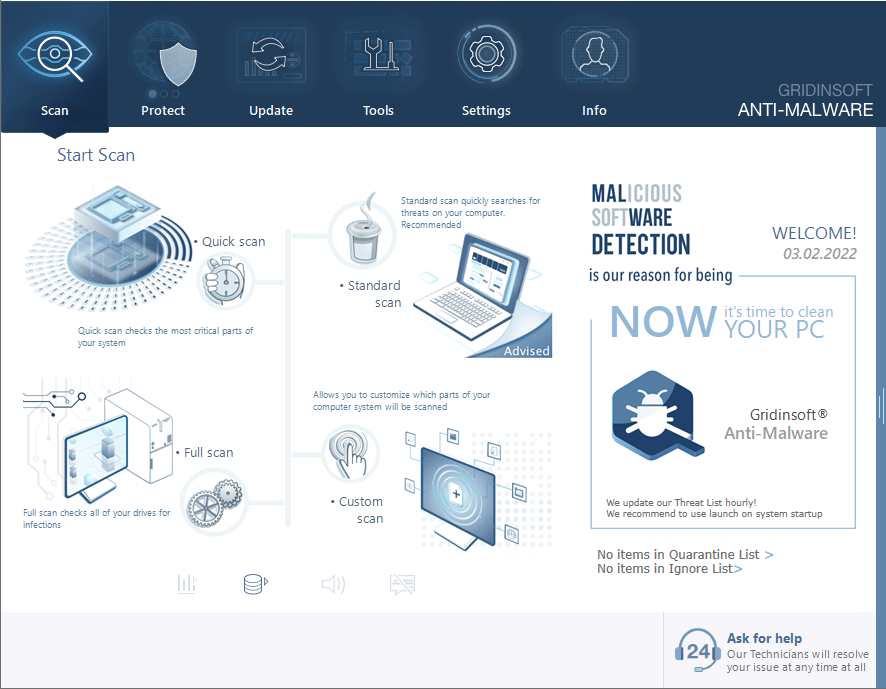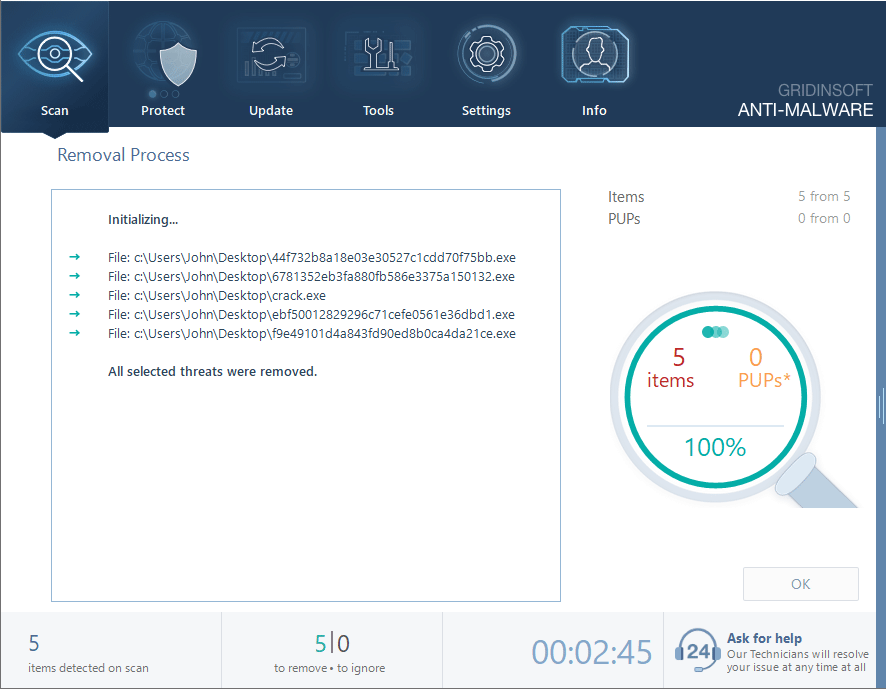Behavior:Win32/Rugmigen.B – Complete Detection and Removal Guide
Behavior:Win32/Rugmigen.B Summary
| Threat Name | Behavior:Win32/Rugmigen.B |
|---|---|
| Type | Behavioral Detection (Trojan Downloader/Infostealer) |
| Detection Method | Heuristic Analysis by Microsoft Defender |
| Affected Systems | Windows 7, 8, 10, 11 |
| Risk Level | High |
| Main Symptoms | Continuous “Threat Blocked” notifications, system slowdowns, unauthorized registry modifications, unusual network connections |
| Distribution Methods | Malvertising, fake browser updates, compromised software, Discord CDN |
| Primary Payload | Infostealers (Lumma Stealer, Vidar, RecordBreaker, Rescoms) |
What is Behavior:Win32/Rugmigen.B?
Behavior:Win32/Rugmigen.B is a detection name used by Windows Defender to flag suspicious activity. It commonly delivers infostealers, targeting sensitive data such as login credentials. It can lead to data theft, system compromise, and performance degradation through activities like cryptomining. In this post, we will take a detailed look at what this threat is as well as how to remove it.
Source: Microsoft Security Intelligence, detection data compiled from Q3 2023 to Q1 2024
Behavior:Win32/Rugmigen.B Overview
Behavior:Win32/Rugmigen.B is a detection name used by Windows Defender, particularly noted in recent user reports, where individuals experienced continuous “Threat Blocked” notifications. These notifications, occurring every 4-5 minutes, suggest active threat blocking by the antivirus, likely Windows Defender. The “Behavior” prefix indicates a behavioral detection, meaning the software identified suspicious activities rather than a specific file signature.
According to Microsoft’s security research, Windows Defender uses heuristic analysis to detect Rugmigen variants, monitoring for specific patterns of suspicious behavior rather than relying on traditional virus signatures. This approach is particularly effective against evolving threats that frequently change their code to evade detection, similar to how Trojan:Script/Phonzy.B!ml and other modern malware operate.

The Behavior:Win32/Rugmigen.B is a variant or detection name for the Rugmi malware family. Rugmi is classified as a Trojan downloader, a type of malware designed to fetch and install additional malicious software onto the infected system. This family has been extensively documented in cybersecurity reports, with significant activity noted in late 2023 and early 2024, and its detection rates have surged, reaching hundreds per day by recent accounts.
Technical Details
Rugmi, and by extension Behavior:Win32/Rugmigen.B, operates with a sophisticated structure comprising three distinct components. The Downloader is responsible for fetching an encrypted payload, often from remote servers, which enhances its ability to evade detection. The Internal Loader executes the payload using internal resources, allowing it to run without relying on external files initially. The External Loader runs the payload from an external file on the disk, providing flexibility in deployment.

These components enable Rugmi to act as a loader for various infostealers, including Lumma Stealer, Vidar, RecordBreaker (also known as Raccoon Stealer V2), and Rescoms. Infostealers are particularly dangerous as they can extract sensitive information such as login credentials, browsing history, and cryptocurrency wallet details.
Key Technical Characteristics
Based on Microsoft’s security analysis and user reports, Behavior:Win32/Rugmigen.B exhibits these technical characteristics:
- Process Injection Techniques: The malware injects malicious code into legitimate Windows processes to evade detection and gain system privileges.
- Anti-Analysis Capabilities: It employs techniques to detect and evade analysis environments, including virtual machines and debugging tools.
- Encrypted Communication: Communication with command and control servers is encrypted to avoid network-based detection.
- File System Manipulation: Creates, modifies, or deletes files in system directories without proper authorization.
- Registry Modifications: Makes unauthorized changes to the Windows registry, particularly to autorun keys that ensure persistence after system reboots.
The behavior detected under Win32/Rugmigen.B includes unauthorized system alterations, such as the appearance of unfamiliar files, changes in system settings, and attempts to disable security software. User reports indicate persistent issues even after system restores, similar to problems seen with DWM.exe issues and other system process manipulations.
Common File Locations
Behavior:Win32/Rugmigen.B typically creates or modifies files in these locations:
%TEMP%directory with random filenames%APPDATA%\Microsoft\Windows\with legitimate-looking names%LOCALAPPDATA%\Temp\with executable files disguised as system componentsC:\ProgramData\with hidden directories containing payload files
Registry Modifications
The malware typically modifies these registry keys to maintain persistence:
HKEY_CURRENT_USER\Software\Microsoft\Windows\CurrentVersion\RunHKEY_LOCAL_MACHINE\SOFTWARE\Microsoft\Windows\CurrentVersion\RunOnceHKEY_CURRENT_USER\Software\Microsoft\Windows\CurrentVersion\Explorer\Shell FoldersHKEY_CURRENT_USER\Software\Microsoft\Windows\CurrentVersion\Policies\System
Distribution and Prevalence
The distribution methods for Rugmi, and thus Behavior:Win32/Rugmigen.B, are diverse. Common vectors include malvertising, where malicious advertisements trick users into downloading infected files, and fake browser updates that pose as legitimate updates to exploit user trust. It also spreads through compromised software, infecting installations of popular programs like VLC media player or OpenAI ChatGPT. Additionally, it leverages Discord’s content delivery network to host and disseminate malware, taking advantage of the platform’s widespread use, similar to techniques used by Advanced Window Manager and other adware threats.
Recent telemetry data, as reported in cybersecurity analyses, shows a significant increase in detections, with spikes noted in October and November 2023, escalating to hundreds per day. This surge indicates active campaigns by threat actors, often operating under a Malware-as-a-Service (MaaS) model, where Rugmi is sold on subscription bases to other malicious actors, with prices ranging from $250 monthly for basic access to $20,000 for source code rights.
Impact and Risks
The impact of Behavior:Win32/Rugmigen.B and related Rugmi variants is substantial, affecting both individual users and potentially organizational systems. Key risks include data theft, as infostealers deployed by Rugmi can extract usernames, passwords, and financial information, leading to identity theft or financial loss.
The malware also compromises systems by providing remote access to attackers, enabling further exploitation or ransomware deployment. Additionally, its malicious activities, such as cryptocurrency mining, can degrade system performance, as noted in some removal guides. For example, recent forum posts, dated March 19, 2025, highlight user experiences with Behavior:Win32/Rugmigen.B. Users reported continuous notifications, with attempts at system restores failing to resolve the issue.
Key Risks of Behavior:Win32/Rugmigen.B Infection
- Data Theft: Credentials, financial information, and personal data can be stolen
- Identity Theft: Stolen data can be used for identity fraud
- Financial Loss: Direct theft from financial accounts or cryptocurrency wallets
- System Damage: Core system files may be modified or corrupted
- Performance Degradation: System resources used for cryptomining
- Additional Malware: Acts as a gateway for other malicious software
How to Remove Behavior:Win32/Rugmigen.B
Automatic Removal with GridinSoft Anti-Malware
For the most effective and straightforward removal process, we recommend using specialized anti-malware software. GridinSoft Anti-Malware is specifically designed to detect and remove modern threats like those that trigger the Behavior:Win32/Rugmigen.B detection.

Download and install Anti-Malware by clicking the button below. After the installation, run a Full scan: this will check all the volumes present in the system, including hidden folders and system files. Scanning will take around 15 minutes.
After the scan, you will see the list of detected malicious and unwanted elements. It is possible to adjust the actions that the antimalware program does to each element: click "Advanced mode" and see the options in the drop-down menus. You can also see extended information about each detection - malware type, effects and potential source of infection.

Click "Clean Now" to start the removal process. Important: removal process may take several minutes when there are a lot of detections. Do not interrupt this process, and you will get your system as clean as new.

Manual Removal Steps
If you prefer to remove the threat manually, follow these steps carefully. Note that manual removal can be complex and may not remove all components of the threat:
- Boot into Safe Mode: Restart your computer and press F8 during startup to enter Safe Mode with Networking.
- End malicious processes: Open Task Manager (Ctrl+Shift+Esc), go to the Processes tab, and look for suspicious processes. Right-click on any suspicious process and select “End Task.”
- Remove startup entries:
- Press Win+R, type “msconfig” and press Enter.
- Go to the “Startup” tab and disable any suspicious entries.
- Alternatively, open Task Manager, go to the Startup tab, and disable suspicious items.
- Delete suspicious files:
- Check these common locations for malicious files:
- %TEMP% folder (Win+R, type %TEMP% and press Enter)
- %APPDATA% folder (Win+R, type %APPDATA% and press Enter)
- %LOCALAPPDATA% folder (Win+R, type %LOCALAPPDATA% and press Enter)
- Look for recently added files with random names or suspicious extensions.
- Check these common locations for malicious files:
- Clean the Registry:
- Press Win+R, type “regedit” and press Enter.
- Navigate to and check these locations for suspicious entries:
- HKEY_CURRENT_USER\Software\Microsoft\Windows\CurrentVersion\Run
- HKEY_LOCAL_MACHINE\SOFTWARE\Microsoft\Windows\CurrentVersion\Run
- HKEY_CURRENT_USER\Software\Microsoft\Windows\CurrentVersion\RunOnce
- HKEY_LOCAL_MACHINE\SOFTWARE\Microsoft\Windows\CurrentVersion\RunOnce
- If you find suspicious entries, right-click and delete them.
- Reset your browsers:
- For Google Chrome: Settings → Advanced → Reset and clean up → Restore settings to their original defaults.
- For Mozilla Firefox: Help (?) → Troubleshooting Information → Refresh Firefox.
- For Microsoft Edge: Settings → Reset settings → Restore settings to their default values.
- Update and run your antivirus program: Update your installed security software and perform a full system scan.
- Restart your computer in normal mode after completing all steps.
How To Stay Safe?
To address Behavior:Win32/Rugmigen.B and prevent future infections, users are advised to take these steps:
- Use reputable antivirus software: Keep security software like GridinSoft Anti-Malware updated with the latest definitions and run regular scans.
- Avoid suspicious downloads: Do not download software from untrusted sources, especially torrents and free software bundlers.
- Be cautious with email attachments: Never open attachments from unknown senders or unexpected emails.
- Keep your system updated: Regularly update Windows and all installed software to patch security vulnerabilities.
- Enable Windows Defender: Ensure Windows Security features are enabled, including real-time protection and cloud-delivered protection.
- Be wary of browser notifications: Do not accept browser notifications from unknown or suspicious websites.
- Use an ad blocker: Install a reputable ad blocker to prevent malicious ads that can lead to infection.
- Implement proper backup strategies: Regularly back up important data to an external device or cloud storage service.
Frequently Asked Questions About Behavior:Win32/Rugmigen.B
Why does Windows Defender keep detecting Behavior:Win32/Rugmigen.B repeatedly?
Repeated detections indicate that the malware is trying to maintain persistence on your system. Windows Defender may be blocking individual attempts, but the root cause remains. This happens because the malware has established multiple persistence mechanisms or is being reinstalled by another malicious component. A thorough system scan with specialized anti-malware software is recommended to completely remove all components.
Is Behavior:Win32/Rugmigen.B a false positive?
While behavioral detections can occasionally result in false positives, Behavior:Win32/Rugmigen.B is usually a legitimate detection of suspicious activity. If you believe it’s a false positive, you can submit the flagged file to Microsoft for analysis or check if the program comes from a trusted source. However, it’s generally safer to treat the detection as legitimate and take appropriate action.
Can Behavior:Win32/Rugmigen.B steal my passwords?
Yes, programs triggering this detection often have information-stealing capabilities. They may collect passwords, financial details, browsing history, and other sensitive data. Rugmigen.B typically delivers infostealers like Lumma Stealer, Vidar, and RecordBreaker, which are specifically designed to harvest login credentials, cryptocurrency wallet information, and other sensitive data.
Why couldn’t Windows Defender automatically remove the threat?
Microsoft Defender may detect the behavior but sometimes cannot fully remove complex threats for several reasons: the malware might use advanced persistence techniques, have components that are currently in use by the system, or employ anti-removal mechanisms. In such cases, specialized anti-malware tools like GridinSoft Anti-Malware can provide more thorough removal capabilities.
How did my computer get infected with Behavior:Win32/Rugmigen.B?
Common infection vectors include downloading software from untrusted sources, clicking on malicious advertisements, opening infected email attachments, visiting compromised websites, or installing browser extensions with hidden malicious functionality. Rugmigen is also known to spread through fake software updates, compromised software installations, and through Discord’s content delivery network.
Conclusion
Behavior:Win32/Rugmigen.B represents a serious security threat that primarily functions as a downloader for various infostealers. When this detection appears in Windows Defender, it indicates that suspicious behavioral patterns associated with the Rugmi malware family have been identified on your system.
The most effective approach is to use specialized anti-malware software like GridinSoft Anti-Malware to thoroughly scan and clean your system. This ensures all components of the threat are removed, preventing reinfection and protecting your sensitive information.
By following the prevention tips outlined in this guide and maintaining good security practices, you can significantly reduce the risk of future infections and keep your digital life secure.





